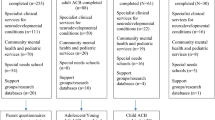Abstract
A diagnostic questionnaire was used to study the abnormalities that parents first noticed, the ages at which parents first noticed these early symptoms, and the main problems the parents complained about in the first consultation. In this study, parents of 141 autistic children below the age of 12 were employed. Approximately 71% of the parents noticed abnormalities m their autistic children by the age of 2 1/2 years. Parents of older autistic children tended more often to report symptoms of mental retardation, ritualistic behavior, and self-injury. This study showed that the Japanese peak of abnormal social behavior, including autistic symptoms as reported by parents, was from the ages of 3 years to approximately 9 years, compared with the U.S. and European peak of 3 to 6 years.
Similar content being viewed by others
Reference
American Psychiatric Association. (1980).Diagnostic and statistical manual of mental disorders (3rd ed.) Washington, D.C.: Author.
Ando, H., & Yoshimura, I. (1979). Speech skill levels and prevalence of maladaptive behaviors in autistic and mentally retarded children: A statistical study.Child Psychiatry and Human Development, 10, 85–90.
Ando, H., Yoshimura, I., & Wakabayashi, S. (1980). Effects of age on adaptive behavior levels and academic skill levels in autistic and mentally retarded children.Journal of Autism and Developmental Disorders, 10, 173–184.
Bartak, L., & Rutter, M. (1976). Differences between mentally retarded and normally intelligent autistic children.Journal of Autism and Childhood Schizophrenia, 6, 109–120.
Chess, S., Thomas, A., & Birch, H. G. (1966). Distortion in developmental reporting made by parents of behaviorally disturbed children.Journal of the American Academy of Child Psychiatry, 5, 226–235.
Coplan, J. (1982). Parental estimate of child's developmental level in a high-risk population.American Journal of Diseases of Children, 136, 101–104.
DeMyer, M. K. (1979).Parents and children. Washington, D.C.: Winston.
DeMyer, M. K., Barton, S., DeMyer, W. E., Norton, J. A., Allen, J., & Steele, R. (1973). Prognosis in autism: A follow-up study.Journal of Austism and Childhood Schizophrenia, 3, 199–246.
Freeman, B. J., Ritvo, E. R., Schroth, P. C., Tonick, I., Guthrie, D., & Wake, L. (1981). Behavioral characteristics of high- and low-IQ autistic children.American Journal of Psychiatry, 138, 25–29.
Hart, H., Bax, M., & Jenkins, S. (1978). The value of a developmental history.Developmental Medicine and Child Neurology, 20, 442–452.
Hingtgen, J. N., & Bryson, Q. S. (1972). Recent developments in the study of early childhood psychoses: Infantile autism, childhood schizophrenia, and related disorders.Schizophrenia Bulletin, 2, 114–126.
Janicki, M. P., Lubin, R. A., & Friedman, E. (1983). Variations in characteristics and service needs of persons with autism.Journal of Autism and Developmental Disorders, 13, 73–85.
Kanner, L. (1943). Autistic disturbances of affective contact.Nervous Child, 2, 217–250.
Kanner, L., & Eisenberg, L. (1955). Notes on the follow-up studies of autistic children. In P. H. Hoch & J. Zubin (Eds.),Psychopathology of childhood. New York: Grune and Stratton.
Lotter, V. (1974). Social adjustment and placement of autistic children: A follow-up study.Journal of Autism and Childhood Schizophrenia, 4, 11–32.
Mesibov, G. B. (1983). Current perspectives and issues in autism and adolescence. In E. Schopler & G. B. Mesibov (Eds.),Autism in adolescents and adults. New York: Plenum Press.
Murphy, A., & Pounds, L. (1972). Repeat evaluations of retarded children.American Journal of Orthopsychiatry, 42, 103–109.
Nagai, Y. (1983). The characteristics and mechanism of food preference in infantile autism.Japanese Journal of Child and Adolescent Psychiatry, 24, 260–278.
Ornitz, E. M., Guthrie, D., & Farley, A. H. (1977). The early development of autistic children.Journal of Autism and Childhood Schizophrenia, 7, 207–229.
Ornitz, E. M., & Ritvo, E. R. (1976). The syndrome of autism: A critical review.American Journal of Psychiatry, 133, 609–621.
Prior, M. R. (1974). Recognition of early signs of autism.Medical Journal of Australia, 2, 183.
Ritvo, R. (Chairman). (1978). Definition of the syndrome of autism.Journal of Autism and Childhood Schizophrenia, 8, 162–167.
Rumsey, J. M., Rapaport, J. L., & Screery, W. R. (1985). Autistic children as adults: Psychiatric, social, behavioral outcomes.Journal of the American Academy of Child Psychiatry, 24, 465–473.
Rutter, M. (1966). Prognosis: Psychotic children in adolescence and early adult life. In J. K. Wing (Ed.),Early childhood autism: Clinical, educational and social aspects. Oxford: Pergamon Press.
Rutter, M. (1970). Autistic children: Infancy to adulthood.Seminars in Psychiatry, 2, 435–450.
Rutter, M. (1978). Diagnosis and definition of childhood autism.Journal of Autism and Childhood Schizophrenia, 8, 139–161.
Rutter, M., Greenfield, D., & Lockyer, L. (1967). A five to fifteen year follow-up study of infantile psychosis. II. Social and behavioral outcome.British Journal of Psychiatry, 113, 1183–1199.
Rutter, M., & Lockyer, L. (1967). A five to fifteen year follow-up study of infantile psychosis. I. Description of sample.British Journal of Psychiatry, 113, 1169–1182.
Schopler, E., Reichler, R. J., DeVellis, R. F., & Daly, K. (1980). Toward objective classification of childhood autism: Childhood autism rating scale (CARS).Journal of Autism and Developmental Disorders, 10, 91–103.
Siverts, B. E., Jensen, L. L., Martinsen, H., & Sundet, J. M. (1982). Differences in use of the diagnostic category “Early Infantile Autism.”Acta Pedopsychiatrica, 48, 123–132.
Wing, L. (1976). Diagnosis, clinical description and prognosis. In L. Wing (Ed.),Early childhood autism: Clinical, educational and social aspects (2nd ed.). Oxford: Pergamon Press.
Author information
Authors and Affiliations
Rights and permissions
About this article
Cite this article
Ohta, M., Nagai, Y., Hara, H. et al. Parental perception of behavioral symptoms in Japanese autistic children. J Autism Dev Disord 17, 549–563 (1987). https://doi.org/10.1007/BF01486970
Issue Date:
DOI: https://doi.org/10.1007/BF01486970




